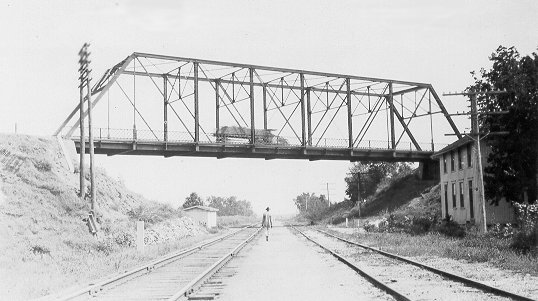CONCRETE ARCH BRIDGES
1907 Bryan 01E2110N3710001
1911 Oklahoma 55D3095E1020003 Oklahoma Br.
1916 Tulsa 72-No Number Missouri Valley Br.
1918 Creek 1918 0139 X
1918 Grady 26E1330N2890002 Topeka Br.
1921 Kingfisher 37E0850N2730000
1923 Washington 74E0188N3950005 Kansas City Br.
1924 Johnston 35E1916N3550001 E.S.Alderman
1932 Tulsa 72E0600N3960002 Rucks-Brandt Co.
1934 Adair 0102 1232 X Gaines Bros.
1939 Grady 26N2838E1350002
By the early 1900s bridge engineers were coming to realize the value of concrete as a building material for highway bridges. Concrete's strength in bearing the compressive weight of loads had long been established, but during the late nineteenth and early twentieth centuries efforts to give it another property, the ability to stretch, known as tensile strength, succeeded when reinforced concrete was developed. Inventors patented a number of ways to accomplish this, with bent or twisted steel bars eventually becoming the prefered technique. Since the shape of the rebar affected how the metal bonded with the concrete various designs appeared on the market. Technical change and improvements of this sort made their way into bridge building where promoters advertised their structures as alternatives to steel trusses, claiming as advantages longer life, simplicity in design, greater reliability, and lower maintenance. A main point was that concrete did not rust and never required painting. The first reinforced concrete bridge was built in San Francisco park in 1889 and proved a major success.
Concrete arch bridges, however, also presented some problems. They required a fair amount of work on the site, including erecting falsework and making molds, needed transportation to move bulky materials, and demanded careful consideration of the bearing quality of the soil for laying foundations. These reasons, along with others, such as a shortage of skilled workers, the unsuitability of arches on streams with low banks, and even an unwillingness to break with the proven dependability of steel trusses, accounted for Oklahoma making less use of this type than appears to be true in many other parts of the United States between 1900 and 1930. A bad experiance with the first major federal aid project may have hurt concrete in the minds of engineers within the state road department. Plans for this bridge, a multi-span concrete arch across the South Canadian River near Oklahoma City, had to be scrapped when the contractor fled the state after failing to design acceptable foundations for the structure. As with all concrete arches, if the foundations are not secure, the structures can sink, develop cracks, and ultimately collapse.
The concrete arch had its greatest utility in Oklahoma for culverts and small spans; of bridges surviving of this type, nearly 80% are 40-foot or less. Although historical records do not shed much light on this group of bridges, it seems clear that virtually all were built by local contractors. Since few localities had standards for construction at that time, these spans often reveal inferior workmanship, slight attention to detail, and inferior materials which have contributed to their presently poor condition, with cracking and spalling being a common problem.
Fortunately some fine examples remain in Oklahoma that reflect both the standard, functionsl, and unadorned arches as well as ones with more architectural and decorative touches. The patented designs of Daniel Luten, an engineer and prolific builder of concrete spans throughout the country, were licensed to several companies, among them the Topeka Bridge and Iron Company that contracted with some Oklahoma counties. In 1918 this company put together an 88-foot bridge outside of Chickasha, its arch narrower than the deck, serving thus as an arched girder, and its plain parapet having incised rectangular panels. Both features are consistant with Luten designs (Figure 33).
|



